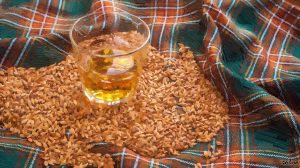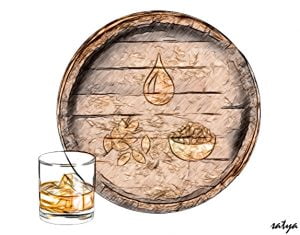Cheers To Scotch! Know ‘Bottled Up’ Facts About Your Favourite Drink

To be labelled Scotch, a whisky must be distilled and initially matured in Scotland. The man who drinks Scotch is one who lives life to the hilt, savouring new challenges and discoveries on a daily basis.
One doesn’t settle and drink something just because it’s there. There are few who drink Scotch to get drunk. First it’s expensive; the cheapest bottle of single malt will cost around Rs 3000 upwards. Second, and much more importantly, each bottle of Scotch contains a history, a tradition, and an attention to detail that the men who drink it are not just downing a beverage, but participating in a celebration of artisanship and the deep pleasures of life.
Becoming a Scotch drinker takes a little work and a bit of tongue maturity. The young man that saddles up for his first bout with the historic elixir is often taken aback by its overt potency. But upon returning a second and third time, he slowly begins to get a sense of what makes Scotch so alluring and enjoyable.
In developing a taste for Scotch, a man embarks on a lifelong journey that will take him along the clear waters of the River Spey, the rugged Highlands, the Isle of Jura and various other parts of Scotland where distillers like to say, “It’s as good as life used to be.”
Therefore, to truly appreciate a good Scotch, a man must have an understanding of its rich history and the process that transforms ordinary barley into an extraordinary drink.

One ventures into the world of Scotch, not because one believes you must drink alcohol in order to be a man, but because if you choose to do so, it should be in the tradition of gentlemen, with a clear conscious and a full heart.
Water of Life
Originally known as “aqua vitae” (water of life) for its healing properties, the first recorded reference to the substance is found in the Scottish Exchequer Rolls of 1494. This distilled beverage was used as a treatment for all kinds of ailments, with many of those being treated reporting of a “warm and calming” sensation.
In 1505, the Guild of Surgeon Barbers in Edinburgh was granted a monopoly over the manufacture of aqua vitae — a fact that reflects the drink’s perceived medicinal properties as well as the medicinal talents of the surgeons.
The royalty and clergy were not the only ones to enjoy whisky, however. The farming community discovered new benefits of the distillation process near the end of the 16th century. Both barley and oats were staple crops of Scotland, but due to the cold, wet climate, the long-term storage of grain was nearly impossible.
Biz Boom
The development of the distillation process for Scotch whisky continued for the next several centuries, surviving taxes, cumbersome government regulations and smuggling to become a commercial industry in the 1700s.
In 1831, the Coffey (Patent) still was produced, increasing whisky’s smoothness and drinkability. This, in combination with the destruction of France’s wine and cognac industry at the hand (or claw) of the Phylloxera bug in 1880, helped ensure worldwide growth of the Scotch industry.
Production Process
The production process of Scotch whisky is surprisingly simple. It involves:
1) Malting: This is the process of turning barley into malt, very similar to the early stages of making beer.
2) Mashing: The dried malt is ground into a coarse flour with the consistency of oatmeal, called “grist”. In the mash tun, water and grounded malt are thoroughly mixed and allowed to steep so that the sugars in the malt are released into liquid. This sugary liquid is called “wort”.
3) Fermentation: The wort is then drawn off and pumped into large wooden or steel vessels called “washbacks”. Once there, it is combined with yeast and allowed to ferment. The length of fermentation can be different depending on the environment, but it generally takes about two days.
4) Distillation: The wash is distilled twice (single malt in a pot still, grain whisky in a Coffey still). The first still is the wash still and is used to separate the water from the alcohol by boiling the wash, collecting the evaporated alcohol which condenses at the top and collecting it in a condenser.
5) Maturation: The unfinished Scotch is then placed in oak barrels, or casks, for maturation to begin. Throughout this process, the whisky becomes much smoother, increases in flavour and begins to retain the golden colour of the barrels inside which it rests. Traditionally second-hand sherry barrels were used to age whisky, but today bourbon barrels are also common. Some producers experiment with other varieties including port, beer, cognac, and even wine. Each barrel passes on a distinct flavour to its contents.
Aged in Scotland
In order to be considered “Scotch”, it must be aged in Scotland for at least three years. Though each whisky reaches maturation at a different age, most are aged anywhere from 8-20 years at present.
Many feel that the longer a scotch is aged, the smoother and more flavourful it becomes; old whiskies are also more rare and cost quite a bit more.
Regions of Birth
Like wine in the old wine regions, Scotch whisky has its own geographic intricacies in Scotland. There are five such regions. They are:
Lowland: The whisky of this region is generally considered to be more mild, mellow, and delicate.
Highland: The largest geographic region for Scotch is known for some famous distilleries.
Islay: It is known for heavier, smokier Scotch varieties. The region has eight distilleries, each with their own unique characteristics.
Speyside: This region is located along the banks of River Spey and boasts of the largest number of distilleries.
Campbeltown: The smallest of the whisky producing regions, it was once home to several distilleries. But now, only three — Glengyle, Glen Scotia and Springbank — are in operation.
How to Drink
The drinking of Scotch whisky should be enjoyable, not intimidating. Everyone has their own opinions on how to drink Scotch, but the following are some general guidelines on the proper way to enjoy this storied spirit.
Glass: While there’s nothing wrong with using a standard tumbler, many scotch experts recommend using a tulip-shaped glass. This allows the whisky to be swirled without spilling and, more importantly, concentrates the aromas at the neck of the glass.
Water: Some Scotch novices may sneer at the introduction of a small splash of water, which is considered to be both stupid and mistaken. While water is not a must, many Scotchmen will throw a little water in with their Scotch to help enhance their ability to taste the individual flavours that can often be masked by the well-known “burn”.
Ice: Many like to add ice, but it is generally considered poor form, simply because it lowers the temperature of the whisky, which in turn can hide or dull the flavours and aroma.
Finally, many men get confused on the issue of whether it should be rendered “whisky” or “whiskey”. In the USA and Ireland, it’s spelt with an ‘e’, but in Scotland it is the real ‘Whisky’.

Indian Scenario
Amrut Fusion: This whisky comes with Jim Murray’s stamp of approval. The widely respected whisky critic placed Amrut Fusion at No. 3 in the Whisky Bible in 2010. Fusion is created from a mix of unpeated Indian barley and peated Scottish barley. These are separately distilled and aged for four years, then “fused” together for three more months. On the palate, it has refreshing notes of orange, peppery spice, gentle peat and some chocolate. The fruit and spice linger longer on the finish with subtle marmalade and sweetness.
Paul John Edited Single Malt Whiskey: The whisky label from the sunny shores of Goa has been delighting whisky aficionados across the world with its supreme balance, distinct character and intense creamy flavours. The Edited starts off with a good hint of peat on the nose, gives way to honey and coffee and lingers on to offer a long finish. It is a treat when indulged neatly.
Kanya by Paul John: The flavoursome Indian single malt from the house of Paul John is aged for seven years in first-fill bourbon barrels. It’s a very complex whisky with a well-balanced dryness. I like the rich creaminess and the soft butterscotch flavours from the oak. This single malt is a slow sipper when you have some time to just hang out and be. After a few drops of water it mellows out nicely while retaining a surprising amount of its spicy character. Indulge with some exotic cheese to pair it on.
Woodburns: It is a home-grown whisky and the first product of Fullarton Distilleries for the Indian market. A labour of love, this full-bodied dram aged in matured oak wood barrels is distinctively smooth on the palate and rounds off beautifully towards the finish. The charring of the barrels gives the whisky a bold and smoky front balanced with a well-rounded peat finish. It bagged a silver medal in “World Blended Whisky”.
Rampur Indian Single Malt Whisky: It comes from India’s oldest distillery Radico Khaitan in Uttar Pradesh. Rampur Single Malt is made from locally sourced barley malt, distilled in traditional copper pot stills and aged in ex-bourbon barrels which give it a unique, smooth and mellow taste with a pleasant, lingering finish. The golden amber dram has a prominent fruity note with toffee in the background and traces of spices.

Comments are closed.